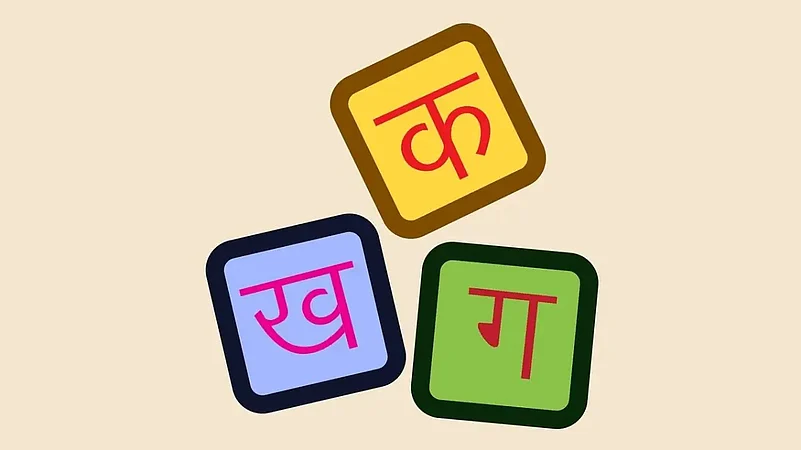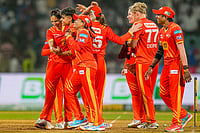Hindi recorded an extraordinary growth in the number of speakers in five decades—from making up 30.39 per cent (13.34 crore) of India’s population in 1961 to 43.63 per cent (52.83 crore) in 2011. But it came at the cost of depriving due recognition to other languages bearing similarities with it. It is a case of basking in borrowed glory, as an analysis of Census data reveals.
Consider the cases of Kurmali and Magahi or Magadhi, grouped since the 1971 Census report as mother tongues under Hindi.
In January 2022, the All India Kurmi Coordination Committee (AIKCC) staged demonstrations at different parts of southwestern West Bengal, demanding the inclusion of their mother tongue, Kurmali, in the Eighth Schedule of the Indian Constitution that lists the country’s 22 official languages. In January 2021, the Kurmi-Mahatos even staged roadblocks at about 50 places across four districts of southwestern West Bengal to press for this demand.
Their demand was not new. In 2009, the second United Progressive Alliance government informed the Parliament that the demand for inclusion of as many as 38 languages, including Kurmali, to the Eighth Schedule, was pending before the Union government. In May 2015, Bidyut Baran Mahato, Lok Sabha member from Jamshedpur, raised the same demand in the Parliament.
Of these 38 languages awaiting recognition, as many as 12—including Kurmali—cumulatively spoken by 12.2 crore people (2011), have been grouped under Hindi as mother tongues since 1971. It’s a proposition that the speakers of these languages oppose.
It is on the growth in the speaker strength of these languages that the claims of Hindi’s growth are based.
In contrast, if we look at the share of people actually speaking Hindi as their mother tongue, it has gone down from 28.02 per cent (12.3 crore) in 1961 to 26.61 per cent (32.22 crore) in 2011. During this period, the population in India grew by 2.75 times, whereas the number of people identifying themselves as Hindi speakers grew by 2.61 times.
Kurmali is the mother tongue of the Kurmi-Mahatos—not to be confused with the Kurmis of Bihar—who live mostly in the trijunction of West Bengal, Jharkhand and Odisha. According to the census of 2001, of the 425,920 Kurmali speakers in the country, 3,06,756 lived in West Bengal and 1,12,916 in Odisha. The language draws influence from Bengali, Hindi, Odia and Santali but remains distinct.
Anglo-Irish linguist George Abraham Grierson, who spearheaded the publication of the Linguistic Survey of India between 1898 and 1927, described Kurmali as “a form of western Bengali” and The Linguistic Survey Of India, Vol V - Part I, said it was sometimes written in Bengali, sometimes in Kaithi, and sometimes in the Odia script. Tapati Ghosh wrote in her introduction to the language in the Census of India publications that “the influence of Bengali language runs parallel with that of Hindi found in their day-to-day communication which is largely influenced by Bengali ecology.” It is also written in the Devanagari script.
The British administration had listed the language under the Bihari group of languages because of its grammatical similarities with other languages of Bihar (mostly Chotanagpur in south Bihar, now Jharkhand) and the Census of 1961 maintained the same. However, the 1971 Census listed under Hindi the whole lot of languages earlier grouped as Bihari. Thus, Kurmali, or Kurmali Thar, became a mother tongue under Hindi.
Sadri, another language from the Chotanagpur area, was spoken by 51.27 lakh people in 2011, it is also known as Sadan, Gawari and Nagpuri or Nagpuria, (the last two names referring to Chotanagpur and not Nagpur of Maharashtra). The 2001 Census of India showed that of about 32.76 lakh Sadri/Nagpuri speakers in India, half lived in Jharkhand and the rest spread over West Bengal, Assam, Odisha and Chhattisgarh.
According to an ICANN (Internet Corporation for Assigned Names and Numbers) document, Sadri is “a mixture of Odia and Hindi language with major regional tribal influence”. The Sadri-Hindi dictionary compiled by linguist Toby Anderson and published in 2020 by the US-based non-profit SIL International said that Sadri’s “lexical similarity” with other languages include 58–71 per cent with Hindi, 47–54 per cent with Odia and 45–61 per cent with Bengali. Literature and radio programmes have been developed using both the Bengali and Devanagari scripts, it added.
The 1971 Census authorities, however, deemed it best to club it under Hindi, the language that the Union government preferred over others.
Chronicle of a Growth Foretold
The 1971 Census marked a crucial juncture in the implementation of India’s language policy, or language politics, in whichever way it might be described. It came three years after India witnessed the first major step towards implementing a pro-Hindi policy—in January 1968, Parliament resolved to push for increasing the use of Hindi in all official work of the Union government. The move found support from Constitutional provisions.
Article 351 of the Constitution said it “shall be the duty of the Union to promote the spread of the Hindi language, (and) to develop it so that it may serve as a medium of expression for all the elements of the composite culture of India…”, while Article 344 made provisions for the “progressive use of the Hindi language for the official purposes of the Union”.
There were two caveats, though. Article 351 said that Hindi’s enrichment should be secured through assimilation “without interfering” with the other Scheduled Languages and Article 344 said that the official language commission “shall have due regard to… the just claims and the interests of persons belonging to the non-Hindi speaking areas in regard to the public services”.
The 1971 change in the language grouping in the census report had significant implications. Only 10 mother tongues were grouped under Hindi in 1961—Awadhi, Baghelkhandi, Braj Bhasha, Bundelkhandi, Chhattisgarhi, Khariboli, Laria, Lodhi, Pardesi and Powari. But the 1971 Census report grouped 48 languages as mother tongues under Hindi.
Apart from Hindustani, which was listed as a separate language in 1961 with 1.22 lakh speakers, languages listed as Bihari in 1961, with 1.68 crore speakers, was grouped under Hindi in 1971, along with Rajasthani and Pahari group of languages, spoken in 1961 by 1.49 crore people and 45 lakh people, respectively.
The languages that went from Bihari to Hindi grouping are Bhojpuri, Magahi or Magadhi, Nagpuri or Sadri, Maithili, Khortha or Khotta and Panchpargania. The Pahari group of languages included Nepali, Kumaoni, Garhwali, Jaunsari, Sirmauri, Chambeali, Mandeali, Bharmarui or Gaddi, Churahi and Bhardwahi. The Rajasthani languages were Bagri-Rajasthani, Dhundhari, Gojri, Harauti, Jaipuri, Khairari, Malvi, Marwari, Mewari, Mewati, Nimadi and Sondwari.
As a result of the new grouping, the share of speakers of the Hindi language shot up from 30.39 per cent (13.34 crore) of India’s population in 1961 to 36.99 per cent (20.29 crore) in 1971, whereas the actual speakers of Hindi as mother tongue stood at 28.02 per cent (12.3 crore) in 1961 and 28.04 per cent (15.37 crore) in 1971.
Of these languages, Nepali was listed as a Scheduled Language in 1992 and Maithili in 2003, making their way out of the grouping under Hindi.
However, similar demands from speakers of Bhojpuri, Bundelkhandi, Banjara, Chhattisgarhi, Garhwali, Gojri, Kumaoni, Kurmali, Magehi, Nagpuri or Sadri and Pahari remain pending before the Union government. Bhojpuri is spoken by 5.05 crore people (2011), while Rajasthani, Chhattisgarhi and Magehi is spoken by 2.58 crore, 1.62 crore and 1.27 crore people, respectively.
The Union has since 2009 maintained that no time frame could be set for decision on such demands.
About Magahi or Magadhi, which is spoken mostly in Bihar, the Linguistic Survey of India’s introduction says, “Magadhi is closely related to Bhojpuri and Maithili and these Languages are sometimes referred to as a single Language, Bihari. These three Languages, together with several other related Languages, are known as the Bihari Languages, which form a sub-group of the Eastern Zone group of Indo-Aryan Languages.”
Magahi speakers have staged a series of demonstrations in recent years, especially in the district of Aurangabad, demanding its inclusion in the Eighth Schedule. For Bhojpuri’s inclusion in the Eighth Schedule, repeated demand has come even from Bihar chief minister Nitish Kumar.
In Rajasthan, politicians such as chief minister Ashok Gehlot and BJP MP Diyas Kumari and organisations such as Rajasthan Language Mothyaar Parishad have demanded Rajasthani’s inclusion in the Eighth Schedule.
On record, the number of mother tongues grouped under Hindi has increased since 1971—the 2011 census listed 55 languages spoken by more than 10,000 people.
Though actually spoken by 32.22 crore people (2011), or 26.61 per cent of India’s population, Hindi became the number one through grouping of other similar languages. Officially, the number of Hindi speakers stands at 52.83 crore, or 43.63 per cent of India’s population.
However, if we exclude from the total number for Hindi the 12 crore speakers of the 12 languages that seek their own recognition, the number of speakers of Hindi language comes down to 40.61 crore, or 33.56 per cent of India’s population. This includes 44 other mother tongues whose speakers have not demanded any separate recognition, at least formally.
In short, the size of India’s Hindi-speaking population is not as big as it is being portrayed to be.
Growth and Patronage: A comparison
In half-a-century, between 1961 and 2011, the population share of all major languages have shrunk. The number of Marathi-speakers came down from 7.69 per cent of the national population in 1961to 6.83 per cent in 2011, and for Tamil-speakers the share has come down from 6.94 per cent to 5.68 per cent, while for the speakers of Telugu, Malayalam, and Kannada the share have come down from 8.57 per cent to 6.68 per cent, 3.87 per cent to 2.87 per cent, and 3.94 per cent to 3.59 per cent, respectively.
Gujarati’s share has remained nearly the same—4.58 per cent in 1961 and 4.54 per cent in 2011—but Odia’s share came down from 3.55 per cent in 1961 to 2.81 per cent in 2011.
The share of Bengali rose slightly—from 7.69 per cent in 1961 to 7.94 per cent in 2011—despite the fact that millions of Bengali-speaking Hindus and Muslims have crossed over from Bangladesh over this period.
Behind the loss of share for Hindi as mother tongue and other major languages, one factor is the higher growth rate of some non-scheduled languages as well as those clubbed under Hindi as mother tongue.
For example, among languages clubbed under Hindi, the number of speakers of Bhojpuri grew by 6.35 times, whereas India’s population grew by 2.75 times during that period and Hindi proper grew by 2.61 times. Again, Magehi grew by 4.5 times, from a population of 28 lakh in 1961 to 1.27 crore in 2011. Chhattishgarhi grew by 5.48 times (1.62 crore in 2011 from 29.62 lakh in 1961).
In 2018, when asked what had the Centre done for the promotion of Bhojpuri, the home ministry had answered, “Bhojpuri is considered a major variety of Hindi. There is no specific effort to protect the Bhojpuri language. However, when works are undertaken for Hindi in academic tasks, Bhojpuri is given due recognition.”
Figures on government spending throw some more lights into another aspect of the government’s preferential treatment of Hindi. In the three years of 2017-18, 2018-19 and 2019-20, the total spending on five ‘classical languages’—Tamil, Telugu, Kannada, Malayalam and Odia—stood at Rs 29 crore.
Hindi, on the other hand, has a dedicated department under the ministry of home affairs —the department of official language. It spent Rs 300 crore in the five years between 2015-16 and 2019-20. There are other government departments that too spend on promotion of Hindi.


























